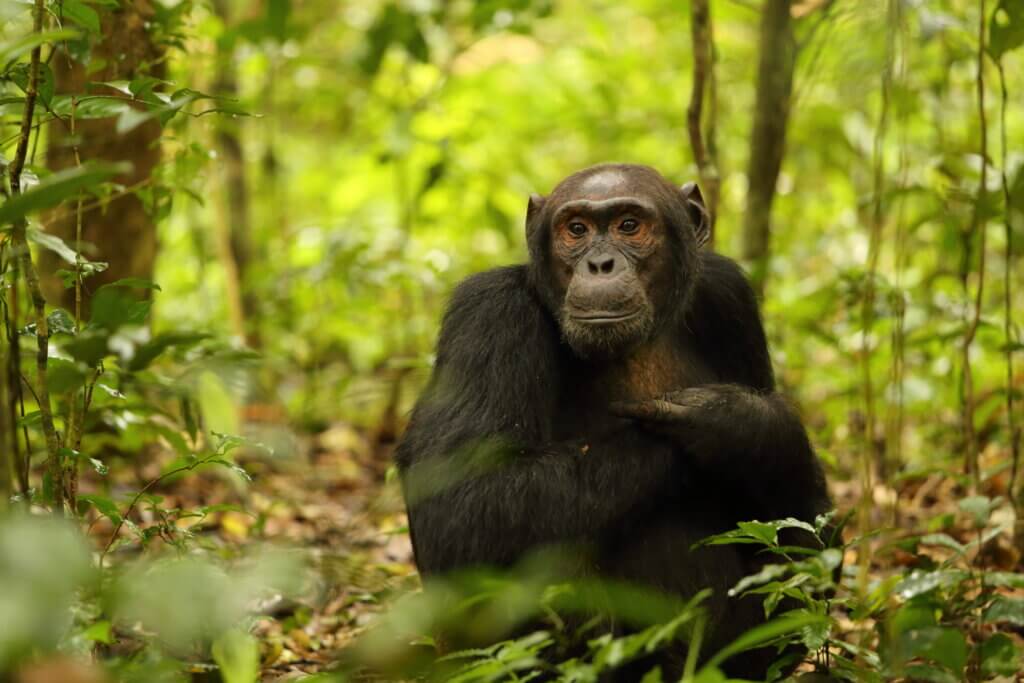
Guy writes: a couple of weeks ago Mark posted an image of a Mountain Gorilla I had taken during a recent trip to Uganda. In the current lockdown, such things now seem particularly distant. On the same trip I was lucky enough to see chimpanzees on three occasions. Twice on organised trips with habituated troops, plus a chance roadside encounter. This photo, of a male sitting quietly on the forest floor, was taken on a trip in Kibale Forest. After an hour or so with our experienced guide visiting previous spots without success, news over his radio meant a brisk walk to catch up with a large group a few kilometres away. As with the gorillas they were very relaxed with people around, though more dynamic and active than their larger cousins, and in some ways I enjoyed this encounter more than the gorillas.
Chimpanzees are found across central and West Africa and, along with bonobos, are our closest living relatives, sharing over 98% of our genetic blueprint. Humans and chimpanzees are thought to share a common ancestor who lived some seven to 13 million years ago. Chimpanzees are highly social typically living in communities of several dozen animals, led by an alpha male and his coalition of male allies. This intelligent animal is one of the few species known to use tools, which primatologist Jane Goodall famously observed in 1960. Nearly all populations have been recorded using tools, modifying sticks, rocks, grass and leaves and using them for hunting and acquiring honey, termites, ants, nuts and water. The species has also been found creating sharpened sticks to spear small mammals. They have a very varied diet, and many will no doubt remember the rather graphic footage from the David Attenborough ‘Trials of Life’ series of chimpanzees hunting, killing and eating a colobus monkey.
The IUCN lists chimpanzee as endangered, with the population in overall decline. Unsurprisingly the increasing human population is primarily to blame, as people impact on more and more of its geographic range. Habitat is cleared for agriculture, logging, mining, oil extraction. New road projects further threaten to degrade and fragment the chimp’s habitat. Bushmeat hunters also target chimps, and offspring are sometimes illegally taken for the pet trade.
In our current global coronavirus pandemic, it is worth remembering that chimpanzees are also susceptible to infectious diseases. Since the 1980s, the Ebola virus has killed them, and Western lowland gorillas, in significant numbers. The disease was first identified in 1976, in two simultaneous outbreaks, one in a village in the Democratic Republic of the Congo near the Ebola River. Fruit bats are believed to be the normal carrier, able to spread the virus without being affected by it. Past outbreaks have devastated great ape populations, particularly gorillas.
Ebola in humans and great apes is closely linked. Many human outbreaks started after people came into contact with infected gorilla or chimp carcasses or bushmeat. Since 1976 the WHO have reported over 20 outbreaks in humans, the worst was the West Africa epidemic from 2013 to 2016, responsible for over 11,000 deaths. The disease has a very high mortality rate, with an average of about 50%. Fortunately, because Ebola is predominantly spread through bodily fluids, like sweat and blood during the last stages of the disease, it is far less contagious than Covid-19.
Covid-19 is of course the latest in a number of viral pandemics, from the infamous 1918 Spanish flu epidemic, infecting about one-third of the world population, through to the more recent Ebola, Middle East respiratory syndrome (MERS) and severe acute respiratory syndrome (SARS) outbreaks. With our ever increasing human population and exploitation of the natural world, it appears other major viral outbreaks are inevitable. Hopefully, alongside tackling the climate crisis, we can start to put in place measures to give nature more space, improve biodiversity and to finally start healing our dying planet.
Image taken with Canon 6D handheld at 1/30 second with a Canon 70-200 f4.0L lens at f4.0 ISO 2000.
[registration_form]